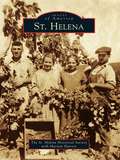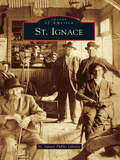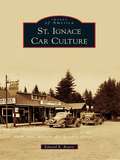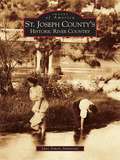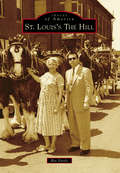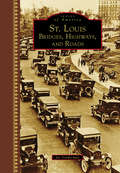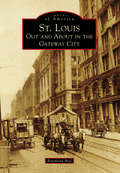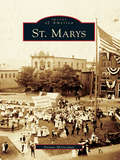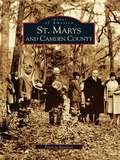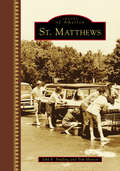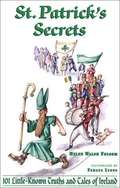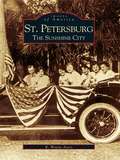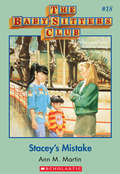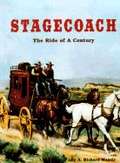- Table View
- List View
St. George Reef Lighthouse
by Guy TowersSituated at the end of a reef six miles offshore of Crescent City, California, stands St. George Reef Lighthouse. Constructed after the wreck of the coastal steamer Brother Jonathan in 1865, the beacon warned mariners of the dreaded "Dragon Rocks" of St. George Reef for nearly a century. This book chronicles the loss of the Jonathan, decades of efforts to make the light a reality, the 10-year construction period, manning of the station by keepers of the US Lighthouse Service and Coast Guard, and the struggles and accomplishments of dedicated volunteers to restore what many lighthouse historians refer to as "America's greatest lighthouse."
St. Helena
by The St. Helena Historical Society with Mariam HansThe town of St. Helena lies in the heart of Napa Valley, America's celebrated wine-producing region located 63 miles north of San Francisco. In 1854, Henry Still and a Mr. Walters purchased 126 acres from the Mexican land grant of Dr. Edward Bale. They offered free lots to anyone who would start a business there, having the foresight to predict a flourishing town in this verdant agricultural area. Premium wine grapes were planted here by the 1870s, and a thriving wine industry began. There are two theories about how the town got its name: either from the local division of the Sons of Temperance or from Mount St. Helena at the northern end of the valley. As the town developed, its residents, along with those from nearby Oakville, Rutherford, Angwin, and Pope Valley, shopped at its stores, attended its churches and schools, tended its fields, and made merry at numerous gatherings. This book captures these activities in photographs dating from 1880 to 1960.
St. Helens (Images of America)
by Tricia Brown Columbia County Museum AssociationRight from its start in 1847, this little town along the Columbia River was built with calloused hands. In these pages, one will see the loggers, shipbuilders, quarrymen, and mill workers. Their wives, mothers, and children are here, too, softening the edges and nourishing a community in the woods. Those early settlers built St. Helens to last, and through decades of booms and busts, tragedies and triumphs, the people's love for this place, so rich in beauty and possibility, shows in more than 200 images. It is a record of endurance, yes, but also of hope.
St. Ignace
by St. Ignace Public LibraryEven before it was named in 1671, St. Ignace was a key part of Michigan history. Before Fr. Jacques Marquette and the Jesuits arrived in the Straits of Mackinac, St. Ignace had a large Native American settlement. With the arrival of the French, fur trading became an important industry. St. Ignace became the county seat in 1882. By the mid-1800s, fishing, shipping, manufacturing, and lumbering were a crucial part of St. Ignace activity. As these industries died down, tourism increased. The area was appealing to tourists for its natural beauty and its fresh air; many came for relief from hay fever and asthma. Initially travelers arrived by ship and train. Ferryboats were important in transporting visitors and goods because of the primitive road system. With its natural harbor, St. Ignace was within easy reach of other Great Lakes ports. With the completion of the Mackinac Bridge in 1957, travel to St. Ignace became much easier. St. Ignace is often referred to as the "Gateway to the Upper Peninsula."
St. Ignace Car Culture (Images of America)
by Ed ReavieSt. Ignace hosted its first car show in 1976 as part of the bicentennial celebration. Over the years, the annual gathering has grown into one of the largest collector-vehicle events in the country. This lakeside community overlooking the mighty Mackinac Bridge and historic Mackinac Island boasts a spectacular waterfront--the perfect backdrop for a stunning array of eye-catching vehicles. In the early years, media referred to this show as "dessert." As the numbers of participants and attendees grew, it became known as the "main course." For teenagers growing up in the 1950s it was all new--cruisin', drive-ins, drag strips, the country's intense love affair with the automobile, and the birth of rock 'n roll. Over 34 years, the St. Ignace Car Show has brought hundreds of automotive legends to town, and car-show traffic set crossing records on the Mackinac Bridge that are unlikely ever to be broken. So fire up the hot rod and cruise back to a simpler time . . . all these cars and still no traffic light!
St. Johns River Guidebook
by Kevin M McCarthyCome aboard! Put on your hat and throw away your cares. Let's float down the most important river in Florida: the mighty St. Johns (though for this north-flowing river, down is up!). We'll start where the river starts, in the marshes west of Vero Beach, and end up 310 miles later at the Atlantic Ocean.This guide describes the history, major towns and cities along the way, wildlife, and personages associated with the river. You'll go by Sanford and Georgetown, Palatka and Orange Park. And at the mouth of the river, you'll encounter the metropolis of Jacksonville and the Naval Station in Mayport.You'll meet some of the most important people in our state's history: Jean Ribault, John and William Bartram, Zephaniah Kingsley, Harriet Beecher Stowe; as well as many important groups: Timucuan and Seminole Indians, runaway slaves, British and Spanish settlers, and missionaries.You will see manatees and jumping fish and lots of species of birds. Away from the big towns on quiet weekdays, you will experience a solitude and closeness to nature that may surprise you in this very populated state.This new edition has completely updated traveling information, including websites and phone numbers.Next in series > >See all of the books in this series
St. Joseph County's Historic River Country
by Jane Simon AmmesonRiver Country is the name given to St. Joseph County, Michigan, an area of historic small towns including Three Rivers, Mendon, Centreville, Constantine, Sturgis, and Nottawa. Home to one of the largest Amish populations in the state, it is a place of meandering roads often frequented by horse-driven black buggies. The county's towns, many of which are on the Michigan and National Registers of Historic Places, feature architecture that harkens back to the 1800s with styles ranging from Italianate and Greek Revival to Queen Anne and Colonial. This book chronicles River Country's historic development, with insight into the businesses, personalities, activities, and architecture that have contributed to its remarkable charm and character.
St. Joseph and Benton Harbor
by Elaine Cotsirilos ThomopoulosTwo distinct communities which share equally vibrant histories, the twin cities of St. Joseph and Benton Harbor possess a rich heritage rooted in agriculture, manufacturing, transportation, and tourism. Through more than 200 photographs, this book documents the cities' development from the time when pioneers first struggled to create a community in the wilderness. It pays tribute to the men and women who labored to establish farms and industries, and celebrates the delightful beaches and amusement parks-such as the House of David and Silver Beach-that have brought joy to generations of residents and visitors alike.
St. Lawrence County Portraits
by Patricia Harrington Carson E. Anne MazzottaSt. Lawrence County Portraits is a tribute to the citizens who shaped New York State's largest county. St. Lawrence is a county with many natural attributes: immense forests, navigable rivers, and vast tracts of fertile land. All of these have been instrumental in drawing people to the area. Reflected in St. Lawrence County Portraits are the influences of a strong mix of residents, including the Mohawks, who have called this area home for thousands of years, the European settlers, and those who trace their family history to Canada, just across the mighty St. Lawrence River.
St. Louis
by David A. LossosAs we approach the 241st anniversary of the settlement on the banks of the mighty Mississippi that came to be the metropolis of St. Louis, it is appropriate to look back at this great city. We have precious few physical reminders of the days of Laclede and Chouteau. It wasn't until the mid-19th century that we regularly recorded via photographs the development (and destruction) of the sights that make St. Louis unique. It is through these images that we have the marvelous capability to look back and view our city through the eyes of our predecessors: To see the things that were here decades ago and still look the same; to see things that no longer exist, and to see what we have replaced them with; to see what we have preserved, and what we have discarded; and to see the present via the images of the past. There is no way to encompass all the changes that this city has seen in one book. The views in this book will give the reader a representative selection of the more recognizable sights in the St. Louis metropolitan area. The intent is to include most of the major places and things that everyone identifies with St. Louis. But also included are more obscure photos that show scenes with which many of our ancestors would also identify. There will always be progress, but that which is lost is worth remembering. So sit back, relax, and take a stroll down the streets of St. Louis as our ancestors knew them.
St. Louis's Delmar Loop
by M. M. Costantin Joe EdwardsIn 1902, magazine publisher Edward Gardner Lewis needed greater space for his thriving business, then based in downtown St. Louis. He headed west, out Delmar Boulevard a mile past the city line, and bought five acres of open land adjacent to the loop in the trolley tracks that sent the 10D streetcar back downtown. By 1903, Lewis was building a complex that included the Woman's Magazine Building, a five-story octagonal tower with an eight-ton searchlight in its dome. In 1906, University City was incorporated, and Lewis became its first mayor, serving three terms. In 1913, Lewis went west again, this time to found the utopian colony of Atascadero, California. His octagonal dazzler is now University City's City Hall. In 2007, in its first such list, the American Planning Association named the Delmar Loop one of the country's "Great Streets"--it's a long story.
St. Louis's The Hill
by Rio VitaleThe Hill was named for its proximity to the highest point in St. Louis. Italians, mainly from Northern Italy, immigrated to the area starting in the late 1800s; however, by 1910, Sicilians were also immigrating to the Hill. Agencies in Italy were employed by mining companies and other industries to help Italian citizens gather all the required documentation for immigration. Italians came to the Hill because of its proximity to the factory and the mines and because it was a district that allowed them to purchase land and build a home. The Parish of St. Ambrose was founded 1903. After the original church was destroyed by fire, the new church was completed in 1926. The Hill has been home to some of St. Louis's nationally known residents, including baseball heroes Joe Garagiola and Lawrence "Yogi" Berra.
St. Louis: Bridges, Highways, and Roads (Images of America)
by Joe SondermanEvery street has a story. From the humblest cul-de-sac to the roaring interstates, the roads tell the stories and reveal the character that make each neighborhood unique. St. Louis was born of the great rivers, so its bridges played a crucial role. Together, the names of the roads tell the history of the child of the rivers that became the Gateway to the West. There are the stories behind the French street names pronounced in a uniquely St. Louis manner, the names purged from the map during World War I, and the histories behind the pioneers, politicians, developers, and everyday people who built St. Louis. Here are also the tragic tales of the epic struggle to bridge the great rivers. These photographs, many never published before, will show it all.
St. Louis: Out and About in the Gateway City (Images of America)
by Raymond BialFounded as a humble trading post along the Mississippi River 250 years ago, St. Louis has since grown into a thriving metropolis. It appears to be a calm city, but like the mighty Mississippi, it has powerful undercurrents. Known as the "Gateway to the West," St. Louis was a port city and home to many manufacturing businesses making everything from shoes to ships. St. Louis, though, is perhaps best known for its breweries and distilleries. St. Louis: Out and About in the Gateway City captures the energy of people bustling along the street, dining out and going to movies, hopping a trolley, swimming, picnicking, clip-clopping along in horse and carriage, ice skating, or driving an automobile. It also touches upon issues of the day that had to be overcome--suffrage, the Great Depression, and civil rights, to name a few--and shows the resilient spirit of the people of St. Louis.
St. Marys (Images of America)
by Dennis McgeehanLocated in Elk County atop the Allegheny Mountains, Sancta Marienstadt (St. Marys) was founded in 1842 on the feast day of Mary. Establishing St. Marys as a refuge to preserve their German Catholic roots, the hardy pioneers of the area eventually embraced a multiethnic, progressive cityscape. Early settlers farmed and developed natural resources. When the extractive industries of timber, coal, and clay were exhausted, the town could have withered away. Instead, the industrious people turned to the newtechnologies of carbon and powdered metal. St. Marys flourished, becoming a leader in the world in these fields, and was labeled the "Carbon City." St. Marys recounts the success of this experiment through photographs from the St. Marys and Benzinger Township Historical Society, illustrating the many paths taken by the people of St. Marys to realize the faith of their founders.
St. Marys and Camden County
by Patricia BarefootBounded on the north by the Little Satilla River from neighboring Glynn County and on the east by the Atlantic Ocean, Camden County's southern boundary at the St. Marys River separates Georgia from Florida. Dating from a 1766 land grant, port of St. Marys and Camden County have faced a challenging past, present, and future. Camden's growth and development have been driven by businessmen, adventurers and opportunists, determined "wild swamp Crackers," and hardy, self-reliant, God-fearing men and women.Accompanied by Jonathan Bryan, a planter with an insatiable appetite for virgin tracts of land, Georgia's third and last Royal Governor James Wright visited Buttermilk Bluff in June 1767 and envisioned a city. St. Marys was born, and its street names reflect the surnames of the 20 founding fathers. While the county seat was removed from a quaint St. Marys on more than one occasion, today, the garden spot of Woodbine serves as the seat of county government. Formerly the rice plantation of J.K. Bedell, this small city shares a symbiotic relationship with port of St. Marys and the "City of Royal Treatment" at Kingsland. The history of the county, with its three main towns as well as the outlying, rural areas, unfolds in striking photographs from days gone by. Preserved within the pages of this treasured volume, images reveal Camden and its people in times of tragedy and triumph.
St. Matthews
by John E. Findling Tom MortonSt. Matthews, once a prominent neighborhood of Louisville, is now a fourth-class city within metro Louisville. The first settlers came to the area in the 1780s, and for more than a century St. Matthews was largely an agricultural area where farmers specialized in growing potatoes. By 1900, a commercial district had grown at the intersection of several roads, known locally as the Point, and the land devoted to farming was gradually taken over by new commercial and residential development. After the great flood of 1937 and World War II, Shelbyville Road, the principal east-west street in St. Matthews, was the site of a commercial boom that included malls and other shopping centers, automobile dealerships, and a wide variety of other businesses. Today, the town of St. Matthews is a vibrant economic and cultural center that attracts people from all parts of metropolitan Louisville.
St. Patrick's Secrets: 101 Little-Known Truths and Tales of Ireland
by Helen Walsh FolsomWell, now, have you heard about how the Irish fought for Alexander the Great? Or did you know that at one time the Irish were forbidden to wear trousers? Perhaps you don't know why the Irish revere John Paul Jones or how Jack the Ripper influenced Irish "Invincibles." Ah then, there's many a strange tale and capricious truth hidden in the history and lore of the Green Isle. 101 short, delightful, ironic and even outrageous tales. A list of additional Irish culture and history books, cookbooks and Gaelic/English dictionaries from Hippocrene Books is included.
St. Petersburg: The Sunshine City
by R. Wayne AyersIn the early 1900s, St. Petersburg, located on Florida's sunny Gulf Coast, was a place where dreams came true, where fortunes were won, and where thousands came to bask in the city's golden glow. "The Sunshine City" became its nickname and the advertising mantra that helped catapult St. Petersburg from a sleepy backwater of Tampa and a struggling rail stop to one of the nation's most popular tourist destinations. By the 1920s--often referred to as Florida's boom era--St. Petersburg saw fast and furious growth as the city's most significant institutions, buildings, and attractions came into being. Developers and promoters lured countless settlers and tourists from across the country by touting the city's many virtues and its perpetual sunshine. Almost overnight, St. Petersburg was transformed into a popular tourist mecca with a bustling downtown and waterfront, picturesque residential neighborhoods, lush parks and gardens, and the all the attractions of the day. This fascinating time was documented in both word and image by visitors, new residents, and the energetic players that made St. Petersburg boom.
Stacey's Mistake: Stacey's Mistake (The Baby-Sitters Club #18)
by Ann M. MartinThe hit series is back, to inspire and charm another generation of baby-sitters!Stacey's so excited! She's invited her friends in the Baby-sitters Club to New York City for a long weekend. It's going to be perfect--a party and a sleepover on Friday, a big baby-sitting job on Saturday, and lot of sightseeing on Sunday.But what a mistake! The BSC is way out of place in the big city. Mary Anne sounds like a walking guide book, Dawn is afraid of everything, Kristy can't keep her mouth shut, and Claudia is jealous of Stacey's friends. Can Stacey be in the BSC anymore?The best friends you'll ever have--with classic BSC covers and a letter from Ann M. Martin!
Stagecoach: The Ride of a Century
by A. Richard MansirIn this book, journal entries, photos, maps, diagrams, and original paintings help you imagine what travel was really like back then. Could you live up to the challenge of a stagecoach ride across our huge continent? Climb on up and hold on tight--you're about to find out.
Staging the Great Circus Parade (Images of Modern America)
by Jim Peterson Donna PetersonMilwaukee was home to the Great Circus Parade for almost 30 years. Beginning in 1963 and continuing until 1972, the parade became an annual tradition, except in 1967 when the event was cancelled because of civil unrest. Revived on a smaller scale in 1980, the parade traveled between Baraboo and Chicago until it returned to Milwaukee in 1985. Each year, it grew in size and scope, gaining national prominence. The old-fashioned circus parade became an event of mammoth proportions, requiring an army of volunteers working behind the scenes.
Stairway Walks in San Francisco
by Adah BakalinskyHundreds of stairways traverse San Francisco's 42 hills, exposing incredible vistas while connecting colorful, unique neighborhoods, and veteran guide Adah Bakalinsky loves them all. <P><P>Her updated Stairway Walks in San Francisco explores clandestine corridors from Lands End to Bernal Heights while sharing captivating architectural, historical, pop culture, and horticultural notes along the way. Long-term locals and tourists alike have used the book for over 25 years to adventurously uncover San Francisco's unexpected details. This revised and expanded edition has been thoroughly updated and includes three additional walks, new maps, and new color photographs. A comprehensive appendix lists every one of the city's 600-plus public stairways.
Stairway Walks in San Francisco
by Adah Bakalinsky Mary BurkHundreds of public stairways traverse San Francisco's 42 hills, exposing incredible vistas while connecting colorful, unique neighborhoods - veteran guide Adah Bakalinsky loves them all. Her updated Stairway Walks in San Francisco explores well-known and clandestine corridors from Lands End to Bernal Heights while sharing captivating architectural, historical, pop culture, and horticultural notes along the way. A comprehensive appendix lists every one of the city's 600-plus public stairways. Long-term residents and tourists alike have used the book for over 25 years to adventurously uncover San Francisco's unexpected details.
Stalin's Nose: Across the Face of Europe
by Rory MacleanThis surreal and darkly comic tale is based on the author's journey from Berlin to Moscow, through Czechoslovakia, Hungary, Poland and Romania, only weeks after the fall of the Berlin Wall.

